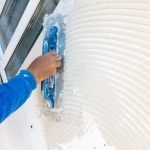Air quality at home is a crucial factor that can have a significant impact on our health and well-being. In this article, we will explore the various ways in which you can improve the air quality in your home to create a healthier living environment for you and your family. From identifying sources of indoor air pollution to implementing simple tips for better air quality, we will cover everything you need to know to breathe easier at home.
Indoor air pollution can stem from a variety of sources, including household products, poor ventilation, and even the materials used in building construction. We will discuss these culprits of indoor air pollution and their potential effects on your health, as well as provide insights into the dangers of poor air quality.
By taking proactive steps to improve indoor air quality, you can reduce the risk of respiratory problems, allergies, and other health issues associated with poor air circulation and polluted indoor environments. Proper ventilation, air purification techniques, humidity control, and HVAC system maintenance are just some of the strategies that we will delve into for achieving cleaner and healthier indoor air.
Join us as we explore how small changes in your home environment can lead to big improvements in your overall well-being by enhancing the air quality around you.
Sources of Indoor Air Pollution
Indoor air pollution can come from a variety of sources, many of which may be present in our homes without us even realizing it. Identifying these culprits is the first step to improving the air quality at home. Common sources include tobacco smoke, cooking and heating appliances, as well as cleaning and personal care products that release harmful chemicals. Additionally, building materials, furniture, and even outdoor air pollution can also contribute to indoor air pollution.
One of the most significant sources of indoor air pollution comes from volatile organic compounds (VOCs) found in many household products such as paints, varnishes, and disinfectants. These chemicals can have both short-term and long-term health effects, making it essential to ensure proper ventilation while using these products indoors. Another common source of indoor air pollution is mold and mildew growth, often a result of excess moisture or water damage in the home.
In order to improve air quality at home, it’s crucial to be mindful of these sources of indoor air pollution. By taking steps to minimize exposure to these culprits and implementing measures for better ventilation and air purification, individuals can significantly reduce the risks associated with poor indoor air quality.
| Sources of Indoor Air Pollution | Identification |
|---|---|
| Tobacco smoke | Recognizing the dangers and minimizing exposure |
| Cleaning products | Choosing safer alternatives and ensuring proper ventilation |
| Mold and mildew | Identifying signs of growth and addressing moisture issues |
The Dangers of Poor Air Quality
Poor air quality at home can have detrimental effects on your health. Indoor air pollution can come from a variety of sources including cooking, cleaning products, smoking, and even furniture or building materials.
These pollutants can lead to a range of health issues such as respiratory problems, allergies, and even more serious conditions such as heart disease or cancer. Understanding the potential risks associated with poor indoor air quality is crucial in taking steps to improve the air you breathe within your home.
One way to improve air quality at home is by using air purifiers. Air purifiers work to remove contaminants from the air, including dust, pet dander, pollen, and even mold spores. Additionally, incorporating indoor plants known for their air-purifying properties can also help to naturally clean the air in your home.
Another important aspect of maintaining good indoor air quality is controlling humidity levels. Excess moisture in the air can lead to mold and mildew growth, which can negatively impact both the air quality and the overall health of those living in the home. It is recommended to keep humidity levels between 30-50% by using dehumidifiers or ensuring proper ventilation in areas such as bathrooms and kitchens.
Regular maintenance of HVAC systems is also essential in improving air quality at home. Air filters should be replaced regularly and HVAC units should be inspected and cleaned by professionals at least once a year. Neglecting these systems can lead to poor indoor air circulation and an increase in pollutants within your home’s environment.
| Indoor Air Quality Improvement Tips | Importance |
|---|---|
| Use of Air Purifiers | Removes contaminants from the air |
| Control Humidity Levels | Prevents mold and mildew growth |
| Maintenance of HVAC Systems | Keeps heating and cooling systems running efficiently |
Tips for Improving Air Quality
Improving the air quality in your home is essential for creating a healthier living environment. Poor indoor air quality can lead to a wide range of health issues, such as respiratory problems, allergies, and even more serious conditions over time. The good news is that there are several simple steps you can take to improve the air quality in your home.
Here are some tips for improving air quality at home:
- Keep your home clean: Regular cleaning can help reduce dust, pet dander, and other allergens that can affect the air quality in your home.
- Use natural cleaning products: Many conventional cleaning products contain harmful chemicals that can release volatile organic compounds (VOCs) into the air. Opt for natural alternatives to keep the air in your home clean and safe.
- Avoid smoking indoors: Smoking indoors can significantly decrease indoor air quality. Encourage smokers to smoke outside or quit altogether to improve the air in your home.
In addition to these tips, you may also consider using an air purifier with a HEPA filter to remove airborne particles from the air. Opening windows regularly to allow fresh air to circulate and investing in houseplants known for their air-purifying properties are also effective ways to improve indoor air quality. By taking these steps, you can create a healthier living environment for you and your family.
Proper Ventilation
When it comes to improving air quality at home, proper ventilation is crucial. Without good indoor air circulation, pollutants can accumulate and lead to poor air quality. Here are some ways to ensure good ventilation in your home:
- Open windows and doors: One of the simplest ways to improve air circulation in your home is to open windows and doors whenever possible. This allows fresh outdoor air to come in and push out stale indoor air.
- Use exhaust fans: In areas like the kitchen and bathroom, where pollutants such as cooking fumes and moisture tend to accumulate, using exhaust fans can help remove these contaminants from the air.
- Install a whole-house ventilation system: For homes with poor ventilation, a whole-house ventilation system can be installed to bring in fresh outdoor air while expelling stale indoor air.
In addition to these methods, it’s important to regularly clean or replace filters in your HVAC system to ensure that it is working efficiently. By improving ventilation in your home, you can significantly reduce the levels of indoor air pollutants and create a healthier living environment for you and your family.
Additionally, consider incorporating houseplants into your home decor – certain types of plants can help filter out common household toxins from the air while adding a touch of greenery to your space. Combined with proper ventilation techniques, using plants as natural air purifiers can contribute greatly towards improving overall air quality at home.
Air Purification Techniques
Indoor air pollution can have a significant impact on our health, so it is crucial to take steps to improve air quality at home. Utilizing air purification techniques can be an effective way to clean the air and create a healthier living environment for you and your family. There are several methods that can be employed to help remove indoor air pollutants and allergens, ultimately improving the overall quality of the air we breathe within our homes.
One effective way to purify the air in your home is by using air filters. High-efficiency particulate air (HEPA) filters can capture small particles that other filters may miss, such as dust, pet dander, and pollen. These filters are ideal for those who suffer from allergies or asthma. Additionally, using activated carbon filters can help remove odors and chemical pollutants from the air, creating a fresher and cleaner indoor environment.
Another natural method for improving indoor air quality is by incorporating plants into your home. Certain plant species, such as spider plants, peace lilies, and snake plants, have been shown to effectively remove harmful toxins from the air. These plants act as natural air purifiers by absorbing pollutants through their leaves and roots. Adding a few of these air-purifying plants to your living spaces can significantly enhance the quality of the air in your home.
In addition to using filters and plants as air purification techniques, there are other methods that can be utilized to clean the air in your home. For example, utilizing an air purifier with UV-C light technology can help eliminate airborne germs and bacteria.
This type of purifier works by disrupting the genetic material of these microorganisms, preventing them from reproducing and effectively cleaning the circulating indoor air. By incorporating these various strategies into your home environment, you can take proactive steps towards improving indoor air quality for better health and well-being.
Controlling Humidity Levels
Understanding the Impact of Humidity
Excess humidity in the home can lead to a variety of issues, one of the most common being mold and mildew growth. When there is too much moisture in the air, it creates the perfect environment for these fungi to thrive. Not only can mold and mildew cause allergic reactions and respiratory problems, but they can also damage your home’s structure and belongings. It’s important to understand how humidity levels can affect your indoor air quality.
Using Dehumidifiers
One effective way to control humidity levels in your home is by using a dehumidifier. These appliances work by removing excess moisture from the air, helping to maintain an optimal humidity level. By keeping your indoor environment dry, you can prevent mold and mildew growth while also creating a more comfortable living space for you and your family. Consider placing dehumidifiers in areas of your home that are prone to excess moisture, such as basements, bathrooms, and laundry rooms.
Tips for Reducing Humidity
In addition to using a dehumidifier, there are simple steps you can take to reduce humidity levels in your home. Ensure that your kitchen and bathroom exhaust fans are properly vented to the outside, as this can help remove excess moisture from these areas. Fix any leaks or water damage promptly to prevent additional moisture from entering your home.
Additionally, using air conditioning during hot and humid weather can help reduce indoor humidity levels. By taking these proactive measures, you can effectively control humidity and improve the overall air quality in your home.
By understanding how to improve air quality at home by controlling humidity levels, you can create a healthier living environment for you and your family while also preventing potential damage caused by mold and mildew.
Maintenance Tips for HVAC Systems
Regular maintenance of HVAC systems is essential to ensure that they are running efficiently and not contributing to poor indoor air quality. When neglected, these systems can become breeding grounds for mold, dust, and other pollutants that can be circulated throughout the home. Here are some tips for maintaining your heating and cooling systems to improve air quality at home.
Change Air Filters Regularly
One of the simplest and most effective maintenance tasks for improving indoor air quality is changing the air filters in your HVAC system regularly. Clogged or dirty filters can restrict airflow, allowing dust, debris, and other allergens to build up in your home. It is recommended to check and change your filters every 1-3 months, depending on the type of filter and household usage.
Keep Vents and Ducts Clean
Dust, pet dander, and other contaminants can accumulate in vents and ductwork over time which can reduce overall air quality. Regularly cleaning vents with a vacuum or damp cloth can help prevent these particles from being circulated throughout your home. Additionally, scheduling professional duct cleaning every few years can also significantly improve air quality by removing accumulated debris.
Schedule Routine Maintenance
Hiring a qualified HVAC technician to perform routine inspections and maintenance on your heating and cooling systems helps ensure that they are operating efficiently. This includes inspecting electrical connections, lubricating moving parts, checking refrigerant levels, and identifying any issues that could impact indoor air quality. By keeping up with regular maintenance, you can minimize the risk of pollutants being released into the air from malfunctioning equipment.
By following these maintenance tips for HVAC systems, you can contribute to improving indoor air quality at home while also extending the lifespan of your heating and cooling systems. Prioritizing the cleanliness and efficiency of these systems will ultimately lead to a healthier environment for you and your family.
Conclusion
In conclusion, the air quality in our homes can have a significant impact on our overall health and well-being. By understanding the sources of indoor air pollution and the associated health risks, we can take proactive steps to improve the air we breathe. Proper ventilation, air purification techniques, controlling humidity levels, and maintaining HVAC systems are all important aspects of creating a healthier home environment.
To improve air quality at home, it is crucial to prioritize proper ventilation. This includes opening windows whenever possible, using exhaust fans in kitchens and bathrooms, and investing in an air purifier if necessary. Additionally, utilizing air purification techniques such as incorporating plants that naturally clean the air can significantly improve indoor air quality.
Controlling humidity levels is another essential aspect of improving air quality at home. By reducing moisture in the air, we can prevent mold and mildew growth, which can contribute to respiratory issues and other health concerns.
Lastly, regularly maintaining HVAC systems is vital for ensuring efficient operation and preventing the circulation of pollutants throughout our living spaces. Overall, taking these steps to improve air quality at home will help create a healthier and more comfortable environment for ourselves and our loved ones.
Frequently Asked Questions
How Can You Improve Indoor Air Quality?
There are several ways to improve indoor air quality. One way is to regularly clean and dust your home to reduce the amount of allergens present. Additionally, using an air purifier can help remove pollutants from the air. Ensuring good ventilation in your home by opening windows when possible can also help improve indoor air quality.
What Are 5 Ways to Improve Air Quality?
Improving air quality can be achieved through various methods. Firstly, reducing the use of harsh chemicals and opting for natural cleaning products can minimize air pollution indoors. Secondly, regularly changing HVAC filters helps trap airborne particles.
Thirdly, adding houseplants can help purify the air naturally by absorbing toxins. Fourthly, properly ventilating your home and keeping humidity levels in check are crucial for maintaining good indoor air quality. Lastly, avoiding smoking indoors and banning other sources of indoor pollution can significantly improve the overall air quality.
How Do I Purify the Air in My House?
To purify the air in your house, you can start by eliminating sources of pollution such as cigarette smoke and harsh cleaning products. Keeping your home clean and well-ventilated is also crucial for improving indoor air quality.
Using an air purifier with a HEPA filter can effectively remove harmful particles from the air. Additionally, adding houseplants like spider plants or peace lilies can act as natural air purifiers by absorbing pollutants and releasing oxygen into the environment.

I’m thrilled to have you here as a part of the Remodeling Top community. This is where my journey as an architect and remodeling enthusiast intersects with your passion for transforming houses into dream homes.





